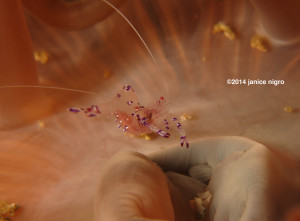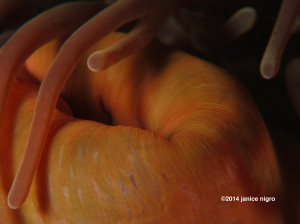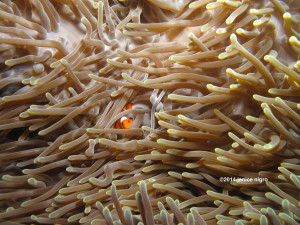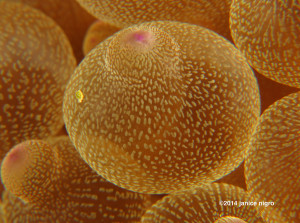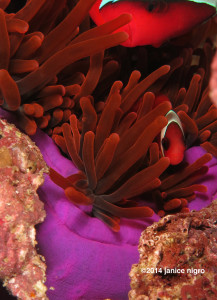Marine Life & Conservation
Is it anenome or anemone?
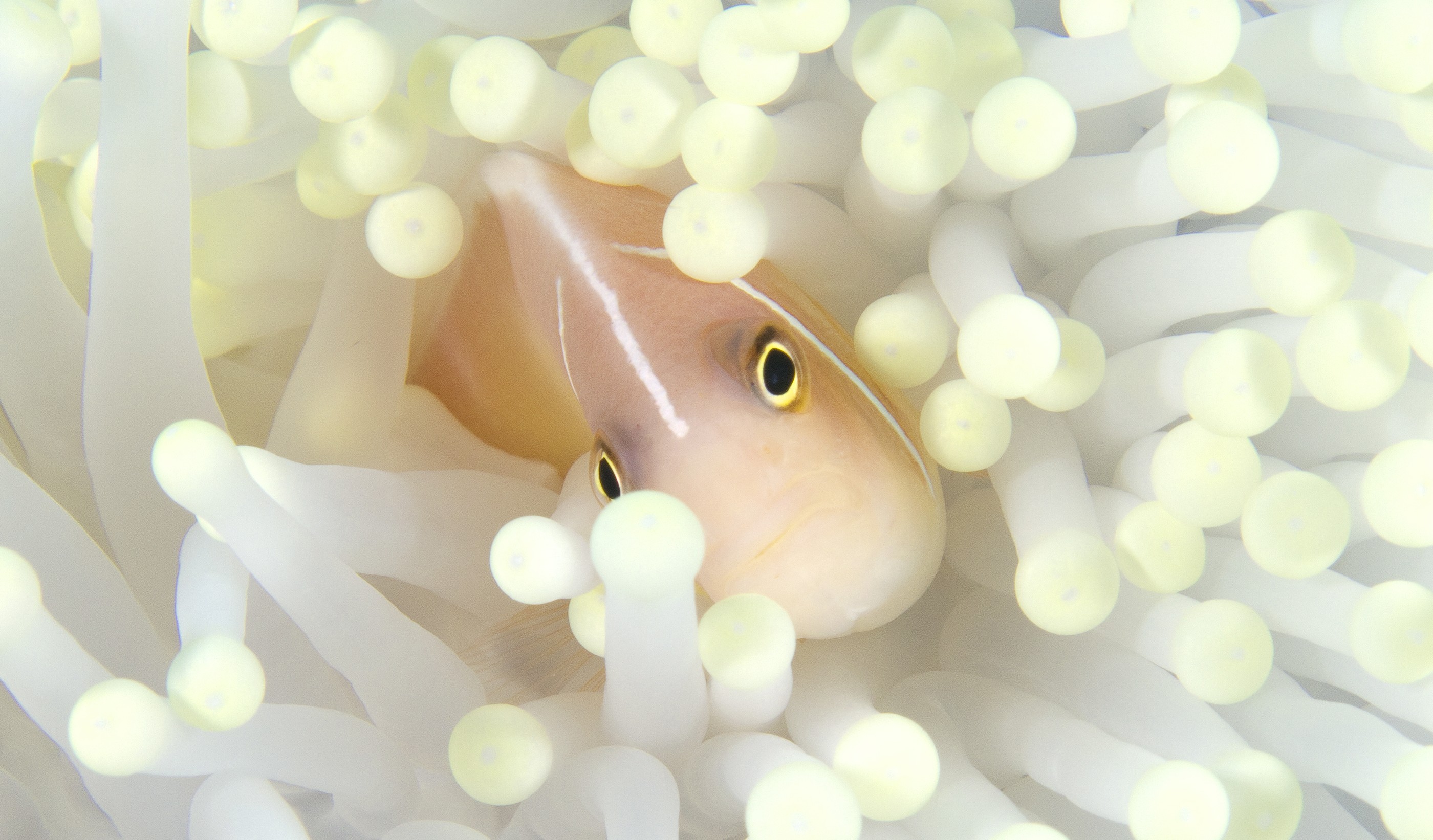
Plenty of tongue-twisting words for underwater creatures exist. Somehow mine for most of my life was simply anemone. Even as I write this, spell correct just corrected the word anemone. For me, it remains a conscious effort to say or write this word correctly. Eventually I realized my mistake but it was only after moving to Norway and while I was learning Norwegian. I am not exactly sure why I would have ever used the word before I started to scuba dive. Anemones were not necessarily in my conscience prior to diving, and it was in a pre-Finding Nemo era. Even then instead of calling him an anemonefish, most people just call him a clownfish, which he is also.
Anemone, however, is not the kind of word that comes up in casual conversation, nor are you going to learn it in language class, not ever. When you are trying to learn a new language, you will read anything to become proficient (even advertisements are suddenly interesting) but luckily, a Norwegian diving magazine exists. One of the ways that I would work on trying to learn Norwegian was to read the magazine. Honestly, I learned some useful words from “Dykking” and among them was anemone. It was then that I finally learned how to really say the word in English (which is easier to pronounce in Norwegian because of the syllable accent), and if you look at the name Nemo it is in fact a part of the right way to say the word. In my dictionary it would have been Neno, which of course makes no sense at all.
I really do not know how my obsession with anemones developed. I suppose they are easy targets for photography because you can readily identify them on your own as a new diver. And because of the anemonefish, although it is nearly impossible to take the fish photos as they constantly move. I like the fish, but I am more enamored of the anemone. Any kind of anemone. I will spot anemonefish hanging midwater and feel compelled to see the anemone over which they play. It must be entirely annoying to the dive guides who are working feverishly to find rare, micro-macroscopic creatures to show me. At the same time, I am easy to please. I am probably the only person who has ever shouted anemonefish (rather than whaleshark or manta) at the end of a dive on approach to the liveaboard boat.
Anyone who knows me, knows of my obsession. “Always looking at anemones,” a guide once said to me. But even he admitted that they are beautiful. I am constantly taking photos of them, and yet dive guides will still humor me by pointing out even more. Sometimes there are some simple scientific principles that I do like to test on them – for example, that color diminishes with depth-because anemones exhibit such natural variation in it. The strobe will change this depth effect, but by the time I reach the surface, I have often forgotten what their color was at depth! You can also test your skills at taking dramatic, abstract shots by photographing the mouth because of shadows and variation in color. Many of these photos end up not so innocent looking though, like a giant Georgia O’Keefe painting of a flower.
The underside scientifically referred to as the column (skirt in common use) of the anemone can be the biggest photographic surprise of all. Textures are fascinating, and colors defy your imagination. Sometimes they are even polka-dotted. Other times the column is wildly uncoordinated with the color of the tentacles. Purple column, red tentacles; yes, I saw this combination in Panglao Beach in the Philippines. How does this color combination evolve and who is this anemone trying to attract or distract?
But what do I really know about anemones? Not a whole lot apparently. I only recently discovered that they are related to coral and that like coral, they also have a symbiotic relationship with algae, one that gives them their color. I was shocked on a second cruise to Komodo within a two-month timeframe, to find a large proportion of “white anemones”. A cruise director informed me that they were not new anemones (because anemones are known to live a long time – as long as 100 years) but instead bleached anemones. Bleaching is the loss of symbiotic algae, which in addition to giving anemones color, produce nutrients for them. I am in complete awe of the array of tentacle colors (even pink, orange, and red), but the color of the column is animal pigment so it is all in the DNA of the anemone. Not only are anemones a mini-habitat to many different crabs, shrimp, and anemonefish, but a photosynthetic factory contributes to the support of all of it.
For all of that natural beauty though, an anemone is not exactly a hospitable habitat. Anemones are animals that sting. They harbor special miniature harpoon-like structures called nematocysts which inject poison/toxin into the flesh of prey, predators, and even other anemones where there are territorial disputes. The anemonefish, however, manages to live amongst the tentacles unharmed as do a variety of crustaceans. This ability is currently attributed to the mucus covering the skin of animals, and it is thought to prevent the triggering of the nematocysts. What magic ingredient within the mucous prevents discharge of the nematocyst remains a secret. Where the mucus comes from is even of controversy, probably because different species of anemonefish and anemones behave differently, but the protective mucus appears to originate from either the fish or the anemone. However, it might be a bit like superman and Planet Krypton because the mucus shield is not an all for one. In the right anemone, fish are protected, and in the wrong one, they can be just as vulnerable as another fish.
How anemonefish find an anemone to live in is another question with diverse answers. In fact, some anemonefish are less discriminating in terms of which type of anemone they can live in, whereas others have a distinct species that they inhabit. It seems that to some degree the fish are attracted by specific chemical signals originating from the anemone and less so by visual cues. This ability seems to be partly due to genetics, which is greatly enhanced if fertilized eggs are located within close proximity of their typical anemone home. It is believed then that the anemone makes factors that subtly influence the eggs predisposing them to responding to the cues and thus, finding a similar home when they grow up.
When you look at an anemone, you do not have to think too much about why the fish might want to live there. It is a beautiful house, you can easily hide in it, and if there is a real threat, the anemone can close itself around you. But anemones also look like they could just feel nice… as long as you are able to avoid the problem of engaging the nematocysts. Research actually shows that fish may engage in certain hedonistic behaviors. Anemonefish in a tank, when isolated from the anemone, for example, will bathe in the bubbles originating from the aerator. Real scientific measurements have been made, however. Cortisol, which is an indicator of stress, is actually found to be decreased in fish that are in contact with certain tactile sensations.
What exactly does an anemonefish do for the anemone? Apparently other people have had the same question (and fortunately got grant money to study it). I had zero ideas for the answer to this question so I did what we all do, I literally typed that question into Google.com. The first link that popped up was “Dancing Nemo: Clownfish wiggles do an anemone good”. No joke and who could resist reading an article with a title like that? This short paragraph led me to the real research article, which has the title “Anemonefish oxygenate their anemone hosts at night”. The bottom line is that the movement of the fish, which are especially active at night, keeps nutrient and gas flow (oxygen) constant over the anemone. Hmm, so maybe as an underwater photographer I may actually be helping the anemone because the fish move constantly when I try to take a photo.
Additional reasons have been proposed for why the fish is beneficial to the anemone as well. The anemone can snack on scraps from the fish, and it is even thought that nutrients from the fish waste are also good for the anemone. Furthermore, the fish protect the anemone from predators, that I would never have guessed, are the lovely butterfly fish. Apparently these fish are also impervious to the stinging by anemones, and without the anemonefish, anemones are quite vulnerable in the natural coral reef habitat. I have myself undergone direct attack by anemonefish (very scary), but I always thought they were protecting their eggs.
There are a thousand lessons to learn about relationships in nature just by looking at an anemone. And I am sure there are many others that we can not see. But this is why there has been so much research performed on them.
The fact that some very violent stuff is taking place within anemones does not change my opinion about them. Perhaps, their beauty is also viewed by other fish, and it is one of their ways to attract prey. It seems like that would be enough to attract me to an anemone, but maybe I was just an anenomefish in another life…
What burning question do you have about symbiotic relationships of sealife???
Marine Life & Conservation
Paul Watson Released as Denmark Blocks Japan’s Extradition Bid

Renowned anti-whaling activist Paul Watson has been released from custody in Greenland after spending five months in detention. Denmark’s Justice Ministry rejected Japan’s request for his extradition, citing insufficient guarantees that his time already served in custody would be credited against any potential sentence.
The 74-year-old Canadian-American was arrested on July 21 in Nuuk, Greenland’s capital, when his ship docked to refuel. His arrest was based on a 2012 Japanese warrant related to a 2010 encounter in Antarctic waters. Japan alleged Watson obstructed operations and caused damage to a whaling research ship during efforts to disrupt illegal whaling. Watson has consistently denied these claims, maintaining his commitment to marine conservation.
Denmark, which oversees extradition matters for Greenland, concluded that while the legal conditions for extradition were met, the lack of assurances from Japan regarding time-served credit made extradition untenable.
In a video shared by his foundation, Watson expressed gratitude and relief, saying, “After five months, it’s good to be out… and good to know they’re not sending me to Japan.” He added that the most difficult part of his time in custody was being separated from his two young sons.
Watson is a pioneering figure in marine conservation, known for founding the Captain Paul Watson Foundation in 2022 after decades of activism with the Sea Shepherd Conservation Society. His bold efforts to defend marine life have earned him widespread support, including from celebrities and conservationists. His work has also been featured in the acclaimed reality TV series Whale Wars.
Watson’s lawyer, Jonas Christoffersen, praised the decision, stating, “We are happy and relieved that Paul Watson is now free.” He added that Watson is eager to reunite with his family and continue his vital work.
The arrest occurred while Watson’s vessel, the M/Y John Paul DeJoria, was en route to the North Pacific with a team of 26 volunteers to intercept a Japanese whaling ship. His foundation described the arrest as politically motivated and emphasized that Watson’s actions were focused on ending illegal whaling practices.
Japan resumed commercial whaling in 2019 after leaving the International Whaling Commission, asserting that whale meat is a cultural tradition. Conservationists, however, continue to challenge these practices, highlighting their impact on marine ecosystems.
Despite the challenges, Watson remains steadfast in his mission to protect marine life and bring attention to whaling practices. His dedication to ocean conservation has made him a globally respected advocate for the environment.
Marine Life & Conservation
12 Days of Zero-Waste Fish-mas

This holiday period, the Marine Conservation Society, the UK’s leading ocean membership charity, invites you to make some simple changes to eating fish this Christmas to help our seas.
Dr Kenneth Bodles, Head of Fisheries and Aquaculture at the Marine Conservation Society, said, “During the festive season, our consumption increases, but so does waste. Sustainability isn’t just about where food comes from – it’s also about how you use it. By reducing waste and making the most out of your seafood, you’re not only taking steps to be more ocean-friendly, but can also help to cut costs during what is often one of the most expensive times of the year”.
The Marine Conservation Society has compiled twelve tips on how to consume seafood sustainably with zero-waste this Christmas:
Buy whole fish instead of fillets
Instead of fillets, consider buying whole fish such as salmon, hake, or lemon sole. By adopting a “nose to tail” approach with cooking, whole-baked fish not only feeds a crowd, but also helps to minimise waste and maximise sustainability by using up every part of the animal, including bones, skin, and fat.
Make fish stock
Leftover fish bones or shells can be put to good use by boiling them to make a nourishing fish stock or bisque. This can be frozen and preserved for later use and makes for a flavourful base in a soup.
Make your own fish pâté
Avoid waste by turning leftover fish, such as smoked mackerel or salmon, into a delicious pâté by blending with cream cheese and lemon. Perfect when paired with crackers.
The sustainability of salmon and mackerel varies depending on where and how it is caught or farmed. For more information on green-rated options, check the charity’s Good Fish Guide.
Buy frozen
By purchasing seafood that is frozen or vacuum-packed, this helps to reduce waste by extending the shelf life of your food.
Fish pie
If you’re wondering what to do with leftover cooked fish, why not opt for a classic fish pie with mashed potatoes, leeks, and a cheesy sauce? A sure crowd pleaser on Boxing Day.
Use the head
Don’t forget the fish head! The meat is incredibly tender and flavourful. The charity recommends a cod’s head curry or recreating Fallow’s renowned cod’s head in siracha butter.
By stretching your ingredients further, not only is this a more sustainable way to enjoy seafood, but also cost-effective by repurposing leftovers and cooking creatively.
Boxing Day brunch
Mix leftover kippers or smoked salmon with scrambled eggs for a tasty, zero-waste, Boxing Day brunch.
For best choice, make sure you buy kippers, or herring, from the North Sea and the North Irish Sea.
Zero-waste storage
A top tip from the Marine Conservation Society to avoid waste is freezing fish offcuts to save for future use.
Crisp up the skin
Even leftover fish skin can be turned into a quick savoury snack by crisping it up in an air fryer with a little olive oil and salt.
Anchovies two ways
Leftover anchovies can either be blended with butter to make a delicious anchovy butter or tossed into pasta for a hit of umami flavour.
The charity recommends opting for anchovies caught in the Bay of Biscay for best choice.
Fishcakes
For an easy, zero-waste meal, leftover seafood trimmings can be mixed with mash and fried in breadcrumbs to make fishcakes.
Pickled mussels
Try pickling mussels in 1:1 vinegar and water, with a dash of sugar for a sustainable, zero-waste snack that can be enjoyed well beyond the festive season.
Mussels farmed in the UK are a seafood superhero. Grown using low-impact methods and harvested by hand, they get all the food they need from the sea around them. This makes them one of the most sustainable, ocean-friendly, and cost-effective seafood options.
Players of People’s Postcode Lottery have raised £6.6M towards the Marine Conservation Society’s vital work in making seafood more sustainable.
Laura Chow, Head of Charities at People’s Postcode Lottery, said: “Fish is a festive favourite for many, but making sustainable choices when it comes to how we buy and eat seafood makes all the difference for our ocean. Support from players of People’s Postcode Lottery has helped the Marine Conservation Society further its sustainable seafood work, so that we can all enjoy healthier, better protected seas.”
The Marine Conservation Society encourages you to make sustainable seafood choices a year-round habit, not just for Christmas. To check how sustainable the seafood on your plate is, you can visit the charity’s Good Fish Guide. The Guide helps consumers and businesses identify the most sustainable seafood using a simple traffic light system, based on where and how species are caught or farmed. Green is the best choice, amber means improvements are needed, and red indicates fish to avoid buying.
Zero-waste gift idea
Why not embrace a zero-waste Christmas by gifting a membership to support marine conservation? It’s a meaningful, low-waste gift that helps protect our ocean for generations to come. Memberships start from as little as £5 a month – the price of a sandwich and drink from your local coffee shop.
Find the latest sustainable seafood advice for wild-caught and farmed seafood on the Good Fish Guide, downloadable to your phone from www.mcsuk.org/goodfishguide.
-

 News2 months ago
News2 months agoIconic SS United States to become the World’s Largest Artificial Reef
-

 News3 months ago
News3 months agoBook Review – 52 Assignments: Underwater Photography
-

 Gear News3 months ago
Gear News3 months agoDYNAMICNORD – New German diving brand enters the British market
-

 News3 months ago
News3 months agoExploring Cenote El Pit: A Diver’s Dream
-

 Gear News3 months ago
Gear News3 months agoTry BARE drysuits (and maybe even win one!) this Friday with Sea & Sea at North West Dive Fest
-

 Marine Life & Conservation3 months ago
Marine Life & Conservation3 months agoBook Review: Coral Triangle Cameos
-

 Blogs2 months ago
Blogs2 months agoDive the Egyptian Red Sea this Autumn with Regaldive
-

 News3 months ago
News3 months ago2024 Ocean Art Underwater Photo Competition Announced


